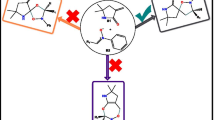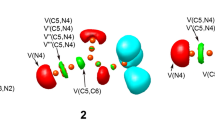Abstract
Many synthetic routes to constructing biologically active heterocyclic compounds are made feasible through the (3 + 2) cycloaddition (32CA) reactions. Due to a large number of possible combinations of several heteroatoms from either the three-atom components (TACs) or the ethylene derivatives, the potential of the 32CA reactions in heterocyclic syntheses is versatile. Herein, the cycloaddition reaction of thiophene-2-carbothialdehyde derivatives and C,N-disubstituted nitrilimines have been studied through density functional theory (DFT) calculations at the B3LYP/6-311G(d,p) level of theory. In the present study, a one-step 32CA and two-step (4 + 3) cycloaddition (43CA) reaction mechanisms involved in TACs reactions and ethylene derivative have been investigated. In all reactions considered, the one-step 32CA cycloaddition is preferred over the two-step 43CA. The TAC chemoselectively adds across the thiocarbonyl group present in the ethylene derivative in a 32CA fashion to form the corresponding cycloadduct. Analysis of the electrophilic \( {P}_K^{+} \) and nucleophilic \( {P}_K^{-} \) Parr functions at the various reaction centers in the ethylene derivative show that the TAC adds across the atomic centers with the largest Parr functions, which is in total agreement with the experimental observation. The selectivities observed in the titled reactions are kinetically controlled.
Graphical abstract










Similar content being viewed by others
Data availability
The data supporting this publication are included in the article and the electronic supporting information.
References
Y. Lan, K.N. Houk, Mechanism and stereoselectivity of the stepwise 1 , 3-dipolar cycloadditions between a thiocarbonyl ylide and electron-deficient dipolarophiles : a computational investigation, (2010) 17921–17927
V. Nair, T.D. Suja, Intramolecular 1 , 3-dipolar cycloaddition reactions in targeted syntheses, (2018). https://doi.org/10.1016/j.tet.2007.09.065
G.C. Tron, T. Pirali, R.A. Billington, P.L. Canonico, G. Sorba, A.A. Genazzani, Click chemistry reactions in medicinal chemistry : applications of the 1 , 3-dipolar cycloaddition between azides and alkynes, 28 (2007) 278–308. https://doi.org/10.1002/med
G.B. Pipim, E. Opoku, R. Tia, E. Adei, Peri-, chemo-, regio-, stereo- and enantio-selectivities of 1,3-dipolar cycloaddition reaction of C,N-disubstituted nitrones with disubstituted 4-methylene-1,3-oxazol-5(4H)- one: a quantum mechanical study, J. Mol. Graph. Model. 97 (2020) 107542. https://doi.org/10.1016/j.jmgm.2020.107542
E. Opoku, G. Arhin, G.B. Pipim, A.H. Adams, R. Tia, E. Adei, Site-, enantio- and stereo-selectivities of the 1,3-dipolar cycloaddition reactions of oxanorbornadiene with C,N-disubstituted nitrones and dimethyl nitrilimines: a DFT mechanistic study, Theor. Chem. Accounts 139 (2020) 16. https://doi.org/10.1007/s00214-019-2529-8
Opoku E, Baffour Pipim G, Tia R, Adei E (2020) Mechanistic study of the tandem intramolecular (4 + 2)/intermolecular (3 + 2) cycloaddition reactions for the formation of polyaza- and polyisoxazolidine-steroids. J. Heterocycl. Chem. 57:1748–1758. https://doi.org/10.1002/jhet.3900
B. Donkor, E. Opoku, Formation of steroid-type skeletons: an ubiquitous natural product, Adv. J. Chem. Sect. B. 2020 (2020) 209–213. https://doi.org/10.22034/ajcb.2020.113671
D.H. Ess, K.N. Houk, Theory of 1 , 3-Dipolar cycloadditions : distortion / interaction and frontier molecular orbital models, (2008) 10187–10198
L. F. Gera, R. Huisgen, I. Kalwinsch, E. Langhals, X. Li, G. moston, K. Polborn, J. Rapp, W. Sicking, R. Sustmann, New thione chemistry, 1996
Mlostoń G, Urbaniak K, Gębicki K, Grzelak P, Heimgartner H (2014) Hetaryl thioketones: synthesis and selected reactions. Heteroat Chem 25(6):548–555. https://doi.org/10.1002/hc.21191
Huisgen R, Rapp J (1997) 1,3-dipolar cycloadditions, 98. The chemistry of thiocarbonyl S-sulfides. Tetrahedron. 53:939–960. https://doi.org/10.1016/S0040-4020(96)01068-X
Mlosto G, Grzelak P, Mikina M, Linden A (2015). Hetero-Diels – Alder reactions of hetaryl and aryl thioketones with acetylenic dienophiles. https://doi.org/10.3762/bjoc.11.63
Huisgen R, Sustmannt R (1999) Thiones as superdipolarophiles. Rates and equilibria of nitrone cycloadditions:9671–9678. https://doi.org/10.1021/ja00143a008
G. Mlosto, A. Linden, H. Heimgartner, Synthesis of ferrocenyl-substituted 1 , 3-dithiolanes via [ 3 + 2 ] -cycloadditions of ferrocenyl hetaryl thioketones with thiocarbonyl S -methanides, (2016) 1421–1427. https://doi.org/10.3762/bjoc.12.136
K. Shioji, Ã.A. Matsumoto, M. Takao, Y. Kurauchi, T. Shigetomi, Y. Yokomori, K. Okuma, Cycloadditions of 3 , 4-dihydro-2 H -pyrrole N -oxide with thioketones and a selenoketone, 80 (2007) 743–746. https://doi.org/10.1246/bcsj.80.743
A. Michalak, A. Fruzin, M. Jasin, G. Mloston, Tetrahedron : asymmetry stereoselective 1 , 3-dipolar cycloadditions of thioketones to carbohydrate-derived nitrones, 27 (2016) 973–979. https://doi.org/10.1016/j.tetasy.2016.08.007
Mlostoń G, Grzelak P, Hamera-Fałdyga R, Jasiński M, Pipiak P, Urbaniak K, Albrecht Ł, Hejmanowska J, Heimgartner H (2017) Aryl, hetaryl, and ferrocenyl thioketones as versatile building blocks for exploration in the organic chemistry of sulfur, phosphorus. Sulfur Silicon Relat. Elem. 192:204–211. https://doi.org/10.1080/10426507.2016.1252368
Jain AK, Sharma S, Vaidya A, Ravichandran V, Agrawal RK (2013) 1,3,4-thiadiazole and its derivatives: a review on recent progress in biological activities. Chem. Biol. Drug Des. 81:557–576. https://doi.org/10.1111/cbdd.12125
M. D. Hanwell, D. E. Curtis, D. C. Lonie, T. Vandermeersch, E. Zurek G. R. Hutchison; “Avogadro: an advanced semantic chemical editor, visualization, and analysis platform” J. Cheminformatics 2012, 4:17. https://doi.org/10.1186/1758-2946-4-17
M. Clark, R.D. Cramer, N. Van Opdenbosch, Validation of the general purpose tripos 5.2 force field, J. Comput. Chem. 10 (1989) 982–1012. https://doi.org/10.1002/jcc.540100804
Opoku E, Tia R, Adei E (2019) DFT mechanistic study on tandem sequential [4 + 2]/[3 + 2] addition reaction of cyclooctatetraene with functionalized acetylenes and nitrile imines. J. Phys. Org. Chem. 32:e3992. https://doi.org/10.1002/poc.3992
Opoku E, Tia R, Adei E (2019) Computational studies on [4 + 2] / [3 + 2] tandem sequential cycloaddition reactions of functionalized acetylenes with cyclopentadiene and diazoalkane for the formation of norbornene pyrazolines. J. Mol. Model. 25:168. https://doi.org/10.1007/s00894-019-4056-x
Opoku E, Tia R, Adei E (2019) Quantum chemical studies on the mechanistic aspects of tandem sequential cycloaddition reactions of cyclooctatetraene with ester and nitrones. J. Mol. Graph. Model. 92:17–31. https://doi.org/10.1016/j.jmgm.2019.06.019
Schlegel HB (1982) Optimization of equilibrium geometries and transition structures. J. Comput. Chem. 3:214–218. https://doi.org/10.1002/jcc.540030212
Kudin KN, Scuseria GE, Cancès E (2002) A black-box self-consistent field convergence algorithm: one step closer. J. Chem. Phys. 116:8255. https://doi.org/10.1063/1.1470195
Hratchian HP, Schlegel HB (2004) Accurate reaction paths using a hessian based predictor–corrector integrator. J. Chem. Phys. 120:9918–9924. https://doi.org/10.1063/1.1724823
H.P.H. and, H.B. Schlegel, Using Hessian Updating To Increase the Efficiency of a Hessian Based Predictor-Corrector Reaction Path Following Method, (2004). https://doi.org/10.1021/CT0499783
Arhin G, Adams AH, Opoku E, Tia R, Adei E (2019) 1, 3-Dipolar cycloaddition reactions of selected 1,3-dipoles with 7-isopropylidenenorbornadiene and follow-up thermolytic cleavage: a computational study. J. Mol. Graph. Model. 92:267–279. https://doi.org/10.1016/j.jmgm.2019.08.004
E. Opoku, R. Tia, E. Adei, [ 3 + 2 ] versus [ 2 + 2 ] Addition : a density functional theory study on the mechanistic aspects of transition metal-assisted formation of 1 , 2-dinitrosoalkanes, J. Chem. 2016 (2016) 10 pages. doi.org/10.1155/2016/4538696
Borketey JB, Opoku E, Tia R, Adei E (2020) The mechanisms of gallium-catalysed skeletal rearrangement of 1,6-enynes – insights from quantum mechanical computations. J. Mol. Graph. Model. 94:107476. https://doi.org/10.1016/j.jmgm.2019.107476
C.Y. Legault, C. Y. CYLview, (2009). http://www.cylview.org
Gaussian 16, Revision B.01, M. J. Frisch, G. W. Trucks, H. B. Schlegel, G. E. Scuseria, M. A. Robb, J. R. Cheeseman, G. Scalmani, V. Barone, G. A. Petersson, H. Nakatsuji, X. Li, M. Caricato, A. V. Marenich, J. Bloino, B. G. Janesko, R. Gomperts, B. Mennucci, H. P. Hratchian, J. V. Ortiz, A. F. Izmaylov, J. L. Sonnenberg, D. Williams-Young, F. Ding, F. Lipparini, F. Egidi, J. Goings, B. Peng, A. Petrone, T. Henderson, D. Ranasinghe, V. G. Zakrzewski, J. Gao, N. Rega, G. Zheng, W. Liang, M. Hada, M. Ehara, K. Toyota, R. Fukuda, J. Hasegawa, M. Ishida, T. Nakajima, Y. Honda, O. Kitao, H. Nakai, T. Vreven, K. Throssell, J. A. Montgomery, Jr., J. E. Peralta, F. Ogliaro, M. J. Bearpark, J. J. Heyd, E. N. Brothers, K. N. Kudin, V. N. Staroverov, T. A. Keith, R. Kobayashi, J. Normand, K. Raghavachari, A. P. Rendell, J. C. Burant, S. S. Iyengar, J. Tomasi, M. Cossi, J. M. Millam, M. Klene, C. Adamo, R. Cammi, J. W. Ochterski, R. L. Martin, K. Morokuma, O. Farkas, J. B. Foresman, and D. J. Fox, Gaussian, Inc., Wallingford CT, 2016
Houk KN, Beno BR, Nendel M, Black K, Yoo HY, Wilsey S, Lee JK (1997) Exploration of pericyclic reaction transition structures by quantum mechanical methods: competing concerted and stepwise mechanisms. J. Mol. Struct. THEOCHEM 398–399:169–179. https://doi.org/10.1016/S0166-1280(96)04970-6
Tirado-Rives J, Jorgensen WL (2008) Performance of B3LYP density functional methods for a large set of organic molecules. J. Chem. Theory Comput. 4:297–306. https://doi.org/10.1021/ct700248k
Wheeler SE, Moran A, Pieniazek SN, Houk KN (2009) Accurate reaction enthalpies and sources of error in DFT thermochemistry for aldol, mannich, and α-aminoxylation reactions. J. Phys. Chem. A 113:10376–10384. https://doi.org/10.1021/jp9058565
Spectus CON, Zhao Y, Truhlar DG (2008) Density functionals with broad applicability in chemistry. Acc. Chem. Res. 41:157–167. https://doi.org/10.1021/ar700111a
Domingo LR, Aurell MJ, Pérez P, Contreras R (2002) Quantitative characterization of the global electrophilicity power of common diene/dienophile pairs in Diels-Alder reactions. Tetrahedron. 58:4417–4423. https://doi.org/10.1016/S0040-4020(02)00410-6
R.G. Parr, L. v. Szentpály, S. Liu, Electrophilicity Index, J. Am. Chem. Soc. 121 (1999) 1922–1924. https://doi.org/10.1021/ja983494x
Koopmans T (1934) Über die Zuordnung von Wellenfunktionen und Eigenwerten zu den Einzelnen Elektronen Eines Atoms. Physica. 1:104–113. https://doi.org/10.1016/S0031-8914(34)90011-2
Domingo LR, Pe P, Pérez P, Sáez JA (2013) Understanding the local reactivity in polar organic reactions through electrophilic and nucleophilic Parr functions. RSC Adv. 3:1486–1494. https://doi.org/10.1039/c2ra22886f
Jaramillo P, Domingo LR, Chamorro E, Pérez P (2008) A further exploration of a nucleophilicity index based on the gas-phase ionization potentials. J. Mol. Struct. THEOCHEM 865:68–72. https://doi.org/10.1016/j.theochem.2008.06.022
L.R. Domingo, E. Chamorro, P. Pérez, Understanding the reactivity of captodative ethylenes in polar cycloaddition reactions. A theoretical study †, J. Org. Chem. 73 (2008) 4615–4624. https://doi.org/10.1021/jo800572a
Domingo LR (2014) A new C-C bond formation model based on the quantum chemical topology of electron density. RSC Adv. 4:32415–32428. https://doi.org/10.1039/c4ra04280h
Reed AE, Curtiss LA, Weinhold F (1988) Intermolecular interactions from a natural bond orbital, donor—acceptor viewpoint. Chem. Rev. 88:899–926. https://doi.org/10.1021/cr00088a005
Reed AE, Weinstock RB, Weinhold F (1985) Natural population analysis. J. Chem. Phys. 83:735–746. https://doi.org/10.1063/1.449486
Ranck JP (2001) Modern physical chemistry: a molecular approach. J. Chem. Educ. 78:1024. https://doi.org/10.1021/ed078p1024
L.R. Domingo, F. Ghodsi, M. Ríos-Gutiérrez, A molecular electron density theory study of the synthesis of spirobipyrazolines through the domino reaction of nitrilimines with allenoates, Molecules. 24 (2019). https://doi.org/10.3390/molecules24224159
Domingo LR, Ríos-Gutiérrez M, Pérez P (2020) A molecular electron density theory study of the participation of tetrazines in aza-Diels-Alder reactions. RSC Adv. 10:15394–15405. https://doi.org/10.1039/d0ra01548b
Domingo LR, Kula K, Ríos-Gutiérrez M (2020) Unveiling the reactivity of cyclic azomethine ylides in [3+2] cycloaddition reactions within the molecular electron density theory. European J. Org. Chem. 2020:5938–5948. https://doi.org/10.1002/ejoc.202000745
Acknowledgments
This work was made possible in part by a grant of high performance computing resources from the South Africa’s Centre for High-Performance Computing.
Code availability
Not applicable.
Funding
Koachie Health Systems (KHS) funded this project through the basic and computational sciences research fund (KHS/MQC/2640/2020).
Author information
Authors and Affiliations
Corresponding author
Ethics declarations
Competing interests
The authors declare no competing interests.
Additional information
Publisher’s note
Springer Nature remains neutral with regard to jurisdictional claims in published maps and institutional affiliations.
Supplementary information
ESM 1
(DOCX 161 kb)
Rights and permissions
About this article
Cite this article
Pipim, G.B., Opoku, E. Unveiling the molecular mechanisms of the cycloaddition reactions of aryl hetaryl thioketones and C,N-disubstituted nitrilimines. J Mol Model 27, 84 (2021). https://doi.org/10.1007/s00894-021-04706-3
Received:
Accepted:
Published:
DOI: https://doi.org/10.1007/s00894-021-04706-3




